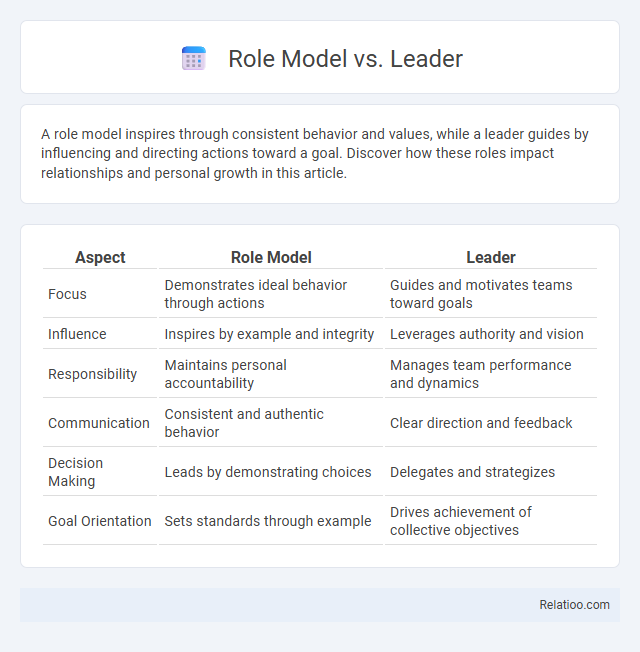A role model inspires through consistent behavior and values, while a leader guides by influencing and directing actions toward a goal. Discover how these roles impact relationships and personal growth in this article.
Table of Comparison
| Aspect | Role Model | Leader |
|---|---|---|
| Focus | Demonstrates ideal behavior through actions | Guides and motivates teams toward goals |
| Influence | Inspires by example and integrity | Leverages authority and vision |
| Responsibility | Maintains personal accountability | Manages team performance and dynamics |
| Communication | Consistent and authentic behavior | Clear direction and feedback |
| Decision Making | Leads by demonstrating choices | Delegates and strategizes |
| Goal Orientation | Sets standards through example | Drives achievement of collective objectives |
Defining Role Model and Leader
A role model exemplifies behaviors, values, and attitudes that others aspire to emulate, often influencing through personal integrity and consistency. A leader guides, motivates, and directs individuals or groups towards achieving specific goals, leveraging authority and vision to inspire collective action. While a role model impacts through example, a leader actively shapes outcomes by steering efforts and decisions.
Key Differences Between Role Models and Leaders
Role models inspire others by exemplifying admirable behaviors and values that people aspire to emulate, while leaders guide and influence others toward achieving specific goals or visions through decision-making and authority. You may follow a role model's example to shape your character, whereas a leader directly directs and motivates your actions in organizational or group settings. Key differences include the source of influence--role models impact through personal example, leaders through positional power and strategy.
Core Qualities of a Role Model
Core qualities of a role model include integrity, empathy, and consistency, which inspire others through authentic behavior rather than authority. Unlike leaders who primarily direct teams or influence through strategic vision, role models lead by example, embodying values that others aspire to adopt. Your ability to demonstrate these qualities daily establishes trust and motivates positive personal growth in those around you.
Essential Traits of Effective Leaders
Effective leaders exhibit essential traits such as clear vision, strong communication skills, and emotional intelligence that inspire and guide teams toward common goals. A role model leads by example, demonstrating integrity, accountability, and consistent behavior that others aspire to follow. Your ability to combine leadership qualities with role model attributes fosters trust, motivates performance, and drives organizational success.
Influence: Inspiration vs. Direction
A role model influences through inspiration, showing by example and embodying values that motivate others to emulate. A leader provides direction, guiding and shaping the actions of their team to achieve specific goals and outcomes. Your ability to balance both inspiration from role models and strategic direction as a leader maximizes your impact on others.
Real-Life Examples: Role Models and Leaders
Real-life examples highlight distinct qualities: role models, like Malala Yousafzai, inspire by embodying values and courage, while leaders such as Nelson Mandela drive change through vision and action. Role models influence behavior and attitudes passively, whereas leaders actively guide teams or communities toward specific goals. Understanding these differences helps you identify when to emulate a role model's character or follow a leader's strategic direction for personal and professional growth.
Impact on Personal and Professional Growth
A role model inspires You through their behavior and values, shaping your personal and professional growth by providing a standard to emulate. A leader drives impact by guiding teams, making decisions, and influencing outcomes that foster skill development and career advancement. While both contribute to growth, role models primarily affect internal motivation and character development, whereas leaders focus on external achievements and organizational success.
Situational Importance: When Each Matters Most
A leader shapes vision and motivates teams during times of change or crisis, providing direction and clarity. A role model influences behavior through consistent actions and values, proving crucial for long-term cultural impact and personal growth. Your ability to recognize when to lead decisively or embody role model qualities ensures effective influence in varied situational contexts.
Can One Be Both? Exploring the Overlap
A leader inspires direction and decision-making, while a role model influences through example and behavior, and a mentor guides with personalized advice and support. You can embody all three by demonstrating strong values, providing guidance, and inspiring others through your actions, creating a powerful overlap that fosters growth and trust. Balancing these roles enhances your impact, as effective leaders often serve as role models and mentors simultaneously.
Cultivating Role Models and Leaders in Society
Cultivating role models and leaders in society requires fostering qualities such as integrity, empathy, and vision that inspire positive behavior and drive collective progress. Your development as a role model involves consistently demonstrating values that others aspire to, while effective leadership demands the ability to guide and influence groups toward achieving common goals. Encouraging mentorship programs and community engagement can strengthen these attributes, creating a culture where both role models and leaders thrive for the betterment of society.

Infographic: Role model vs Leader
 relatioo.com
relatioo.com